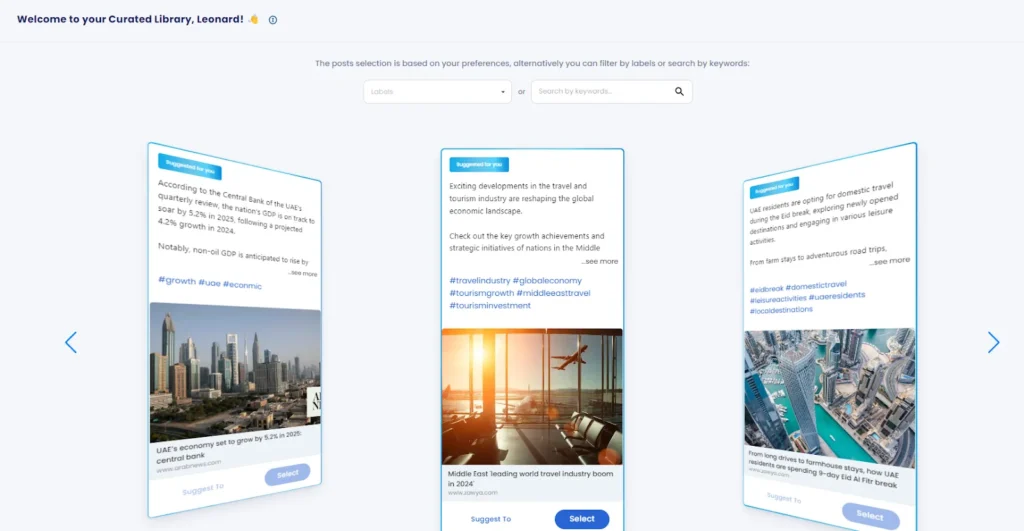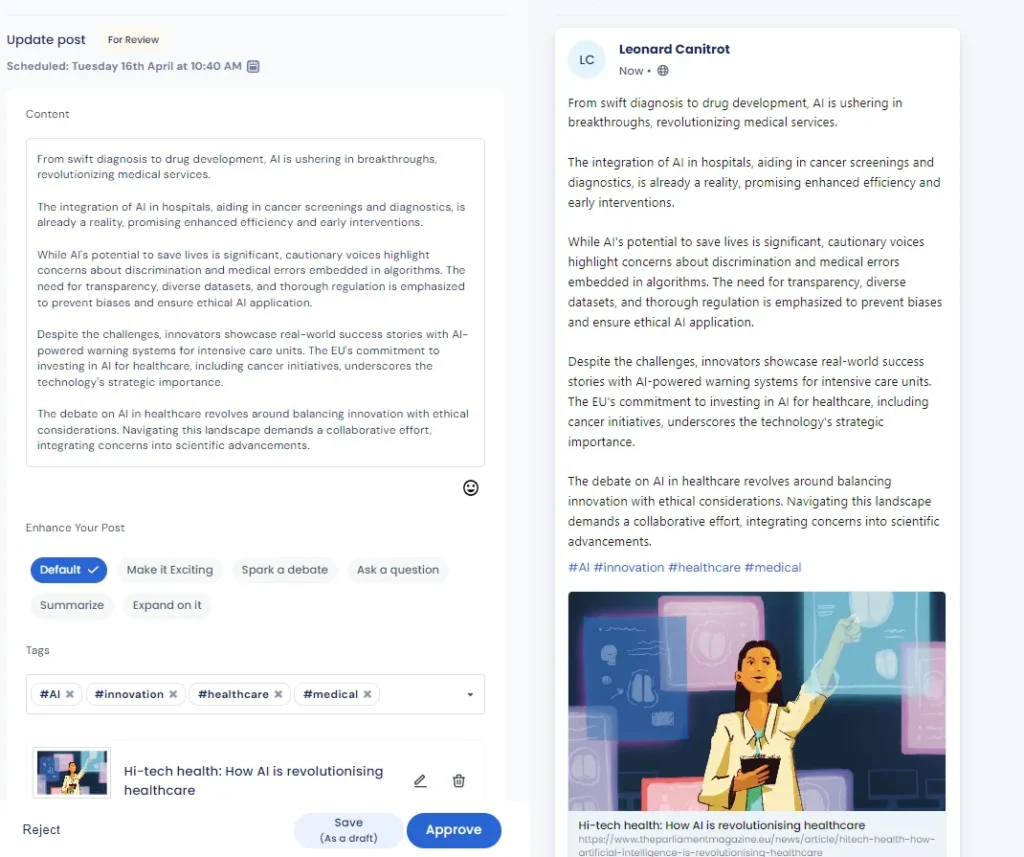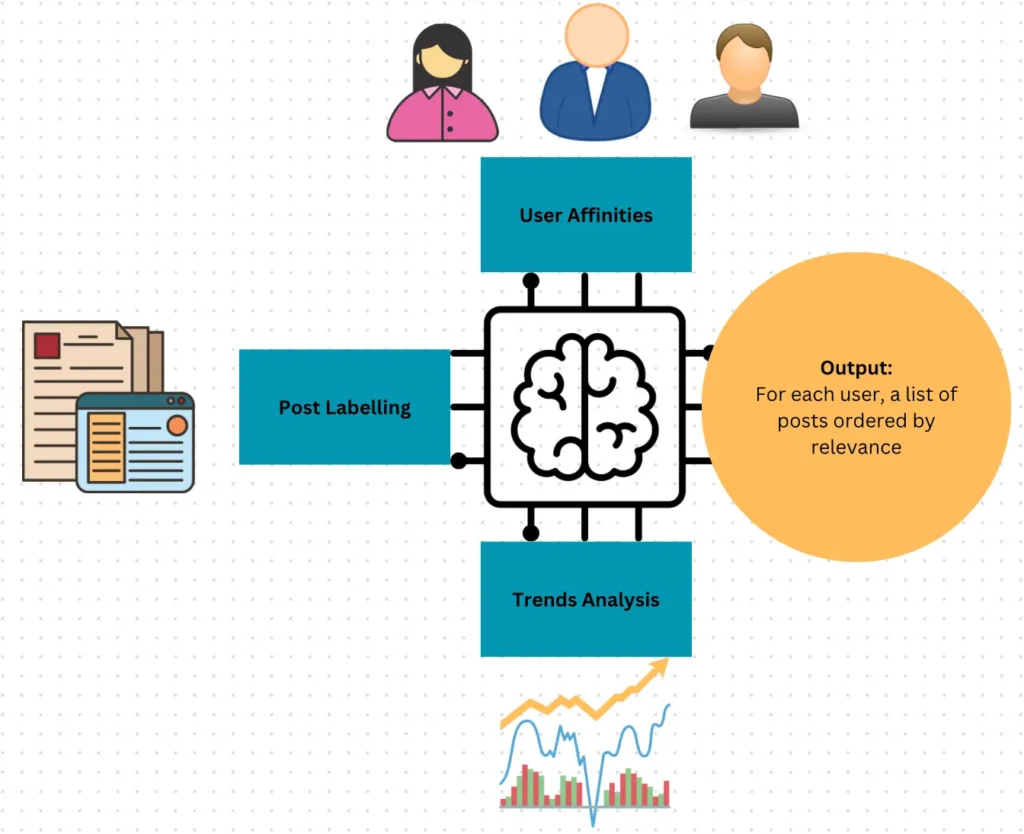Executive Summary
To address the challenge many business leaders face in positioning themselves as thought leaders due to time constraints and daily responsibilities, our platform, Talent-e, leverages advanced AI technologies to democratise content creation. We provide a dual-purpose solution that facilitates access to industry news and insights while enabling personalised content creation that reflects each leader’s unique style.

Key Features:
1. Personalized Content creation:
Utilizing Large Language Models (LLMs) and sophisticated automation, Talent-e curates and generates high-quality business content with full autonomy. This process includes researching, collecting, filtering, and tagging content from trusted sources, ensuring it is audience-appropriate and segmented for easy discovery. The content is then automatically reformatted into digestible formats without losing the essence of the original idea.
2. Dynamic Content Recommendation System:
To ensure the relevance of content for each user, Talent-e developed a content recommendation system that mirrors the precision of social media algorithms. This system understands user preferences, classifies posts, analyses trends, and matches the most relevant content to each user based on various factors, maximising their experience on the platform.
Talent-e stands as a pioneering Gen AI Tech venture in the MENA region, offering a unique service that combines AI-driven personalized content creation with a unique recommendation system. Our solution empowers executives to engage with relevant, insightful content, positioning themselves as thought leaders while navigating their professional growth.
This initiative not only supports individual leadership development but will also contribute to the broader discourse in their respective industries, ultimately reshaping the landscape of executive education and professional development in the region.
The Vision
Despite their expertise, most business leaders remain unsung heroes outside of their immediate professional circles. Why? Their relentless focus on their daily activities creates a lack of time that often sidelines opportunities to communicate and position themselves as thought leaders in their industry.
In a survey conducted by Edelman, 91% of business decision makers described brand thought leadership as ‘important”, and 45% of them said thought leadership had led them directly to award business to a company. These figures will grow bigger with the world’s increasing reliance on social media for any knowledge-related matters.
So how do we support more emerging business professionals to become Thought Leaders?
Leveraging cutting-edge AI and sophisticated automation, we have created a dual-purpose digital solution that combines a curated library for swift access to snackable industry news and insights, combined with a personalized content creation tool that mirrors each leader’s unique style.
How did we do it? Let’s dive in!
Zoom in: A Core System Designed for Scalability
Like Tesla with its Roadster model experienced a few years ago, moving from prototyping to industrialization is not an easy task. In the same way, delivering a personalized service on a global scale requires heavy focus on scalability.
From the start, we knew that a natively static solution plugged in with the same characteristics for every user would not work. This is fundamentally a bespoke, smart, content copywriting service, and it must dynamically suggest content that fits the user’s expectation in both style and substance.
This is where LLM’s (Large Language Models) and advanced automation kick in.
There are 2 main operations in our servicing model: content creation and content recommendation.

The content creation represents a mix of research and curation of high-level business news and insights from trusted sources that we then repackage for the necessary channel.
Content allocation refers to the action of determining which piece of content is best suited to which user, keeping in mind that it needs to be dynamic and pretty much in real time, in the light of Instagram or TikTok recommendation algorithms.
1. Content Creation
From day one, we knew that we had to automate the heavy lifting of content generation in order to serve thousands of individual users as per our mission.
This is why we built an automated system that consistently produces the following tasks:
- Researching and collecting top-tier business content from pre-vetted sources.
- Curating and filtering content with an auto-control layer for audience suitability.
- Intelligent tagging for content segmentation.
- Reformatting into digestible and snackable format while preserving the main idea.
- Prompting engineering to prepare the first draft user version.
These processes are powered by a combination of heuristics and machine learning models. They leverage the power of LLMs and text-to-image models.
If LLMs offer remarkable capabilities for content prototyping and customization, their scalability is challenged by the variability of the quality of the output. These statistical models can obviously lead to hallucinations, requiring a system able to deliver automated feedback loops for a robust output.
On the post image generation side, text-to-image models proved, in our case, to have less variability of the quality in output, making them easier to run into production.
Now that we can produce thousands of content pieces a day, let’s see how we strategically assign them based on each user’s preferences.

2. Content Recommendation
The content that we generate covers very wide business notions and industries: from the rise of open banking in the MENA region, the effect of carbon credits on the net-zero goals, managing the new Gen Z workforce, and anything in between.
Is it filled with subtle nuances, can it go into niche details, or represent a general overview?
Does the user like to go into specifics or keep it at a high level?
Is the user a future leader or a multinational director?
What if someone wants to talk about artificial intelligence trends but doesn’t want to discuss neural network architecture?
This is part of the challenge of making the right recommendations.
To solve this, we developed a system able to understand the user’s preferences, classify the posts and analyze the trends to match the most relevant post for each user.

After matching a list of posts with a user, we then need to rank every post according to the user’s preferences (region, sector, expertise, etc.) considering the current trends while ensuring diversity in the content recommended.
The first solution that comes to mind for recommendation is the well-known machine learning collaborative filtering approach. Usually, it is easy to implement as it only requires the interactions of the users with the items, which in our case are posts.
Unfortunately, in our situation, each post published by our users is unique, so there is no co-occurrence of interactions with the same articles by different users. Therefore, the collaborative filtering assumptions are not met, and this technique cannot be applied at the post level. An idea to overcome this challenge could have been to leverage the co-occurrence at post “topic” level (AI, Leadership, Emerging Markets,….) or article level, but that would not solve our initial problem. It would only help us understand which cross-topics (e.g a user interested in AI could also be interested in Deep Tech) could interest our users.
As a result, the content-based approach seemed the most appropriate one. We often see this approach in e-commerce, music, & video streaming platforms, combined with a collaborative filtering approach, because it has the advantage of addressing the cold start problem. Being able to generate recommendations for new users is key when dealing with a fast-growing user base like ours. As for a significant number of users, we only know their LinkedIn profile information and the ones provided during the onboarding process, but no history of posts selected from our library.
Our approach was to build a multi-level content and user labeling system, enabling precise recommendations, so that we could automatically define the post characteristics (expertise, industry, location,…) and determine the main topic discussed.
In order to generate the labels, there are plenty of machine learning algorithms designed to perform this task. The first decision was to choose either an unsupervised or a supervised approach. The supervised approach appeared to be the most suitable approach, given that we wanted to get consistent labels across our posts and our users in order to be able to easily match them.
Then came the decision to pick the right text classification supervised machine learning algorithm, and given the fact that LLMs are already used for content creation, we decided to explore how to leverage this implementation. After a series of tests, we managed to find a way to perform this supervised task by injecting lists of labels into sequential LLM prompts.

Relying on a LLM to perform this task has proven to be a fast and efficient way. As opposed to using an NLP classifier model, relying on LLM has spared us the need to develop, train, and deploy another machine learning pipeline.
After labeling the users and posts, we then had to match them together. We solved this by building an information retrieval system with a logic very similar to a “search engine”, where we would search “users” in an index of “posts”.
Indeed, to retrieve the most relevant post for a user, we used a sequence of queries containing the affinities (the labels) of each user, which matches them with the post attributes (labels), and then ranks them using a relevance function. The user recieves a final output containing a list of posts ordered by relevance.

We have implemented this recommendation algorithm in both our mobile app engine — to ensure content relevance for our user while scrolling their feed — as well as for our monthly media plan’s unique recommendation.
We are now able to create, curate and allocate business content at scale!
Conclusion
With Talent-e we want to stand at the forefront of AI-driven smart business content in the MENA region, offering a unique blend of personalized content curation and creation to our rapidly growing community of leaders and future leaders.
Our solution is now ready to equip thousands of executives with the insights needed to thrive in their professional journey, redefining the landscape of executive education and personal growth in the region.



Hello there, just became alert to your blog through
Google, and found that it’s truly informative. I’m gonna watch out
for brussels. I will be grateful if you continue this in future.
A lot of people will be benefited from your writing. Cheers!
Escape room lista
Howdy! Do you know if they make any plugins to assist with Search
Engine Optimization? I’m trying to get my blog to rank for some targeted keywords but I’m
not seeing very good results. If you know of any please share.
Many thanks! I saw similar blog here: Warm blankets
I am assured, what is it to me at all does not approach. Who else, what can prompt?
Many thanks.
Instead of criticism write the variants is better.
It is possible to tell, this 🙂 exception to the rules